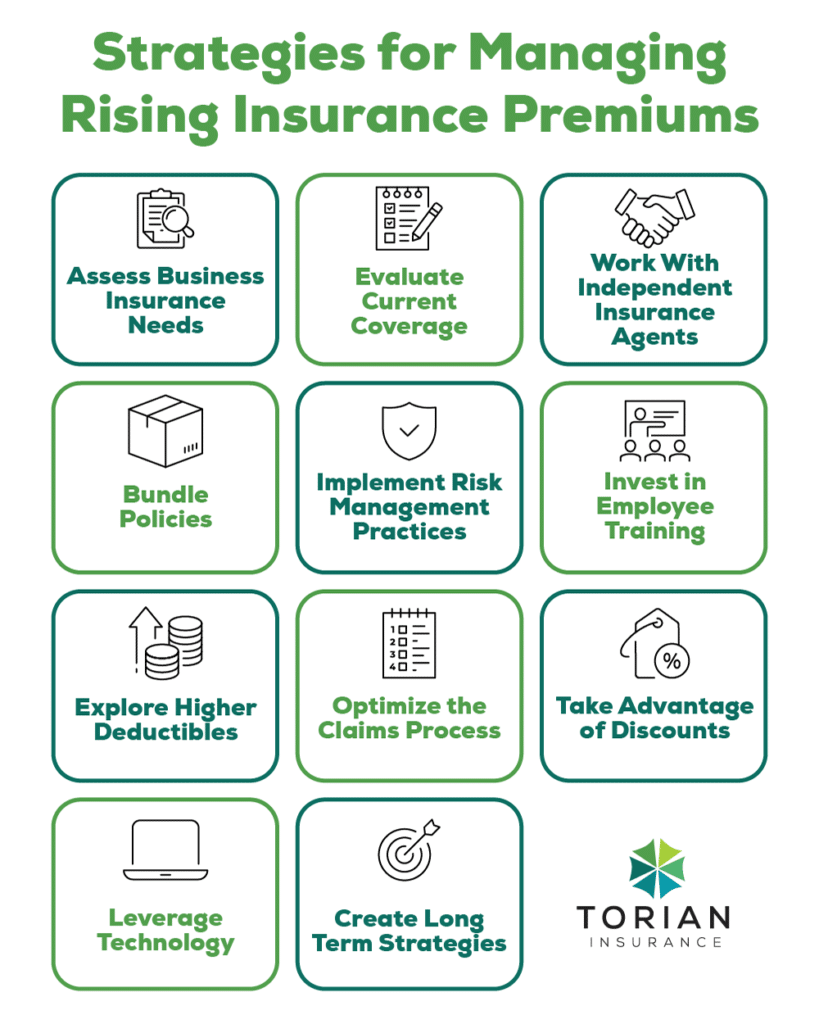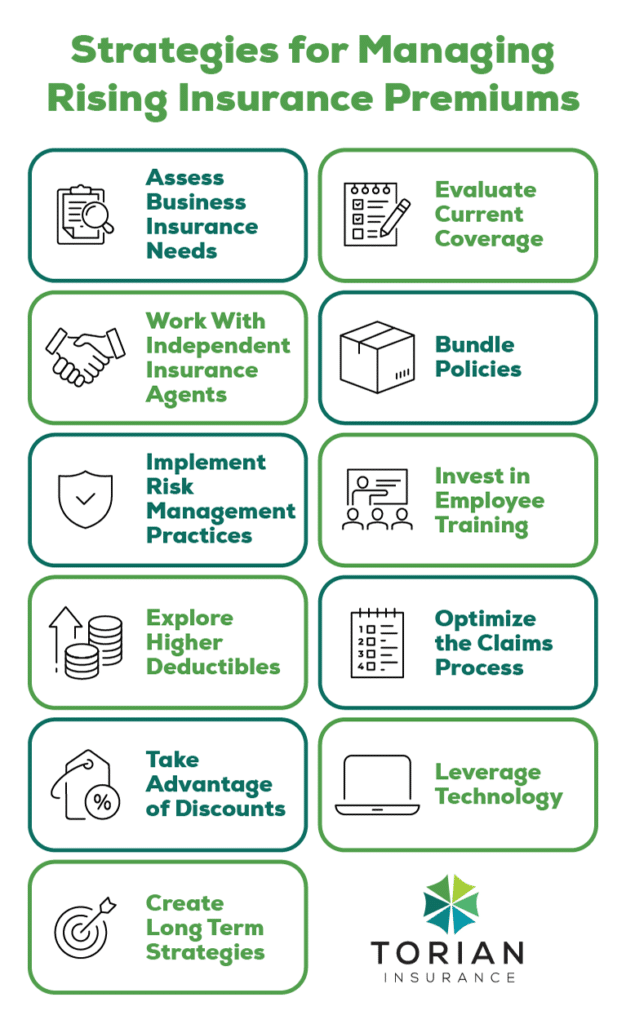Rising insurance premiums are a pressing challenge for businesses across industries. The increasing costs, driven by factors such as economic conditions, higher claims, and evolving risks, can strain financial resources and disrupt business plans. As these expenses climb, they can erode profitability and hinder long-term growth.
For business owners and financial decision-makers, managing escalating premiums isn’t just about cutting costs—it’s about finding sustainable solutions that align with operational needs without compromising vital coverage. This article provides a comprehensive guide to effective strategies that can help mitigate rising insurance premiums while ensuring your company remains protected against uncertainties.
From understanding the causes of premium increases to leveraging tools like risk management practices, this article offers actionable advice tailored to businesses. By the end, you’ll gain the insights needed to optimize your insurance program, control costs, and safeguard your company’s financial health. Let’s dive into the key strategies that will enable your business to thrive, even in the face of increasing insurance costs.
Understanding the Causes of Rising Insurance Premiums
To effectively manage rising insurance premiums, it’s important to first understand their underlying causes. Insurance costs are influenced by a combination of economic factors, industry trends, and business-specific risks. Gaining clarity on these drivers can help you anticipate potential increases and develop strategies to address them.
Economic Influences on Insurance Costs
Insurance premiums are closely tied to broader economic conditions. Factors such as the following can affect how insurers price policies:
- Inflation
- Market volatility
- Financial downturns
For example, inflation drives up the cost of paying claims, including medical bills, repair costs, or replacement expenses. Additionally, turbulent markets can impact the investment income that insurers rely on, leading them to compensate by raising premiums. These economic pressures often result in higher costs across most lines of coverage.
Escalating Claims Frequency and Severity
The number and magnitude of claims directly affect insurance pricing. Increased claims activity—whether due to natural disasters, workplace accidents, or new forms of liability—puts a strain on insurers’ resources.
- Natural disasters: Hurricanes, floods, and wildfires are becoming more common and severe, driving substantial property damage claims.
- Cyberattacks: Rising incidents of data breaches and ransomware attacks are significantly impacting cyber liability coverage costs.
- Litigation trends: Higher settlements or legal judgments in liability cases have also led to premium increases.
When claims become more frequent or costlier to resolve, insurers adjust pricing to ensure they can continue meeting their obligations.
Industry-Specific Risks and Premium Variations
Risks vary across industries, and some sectors inherently face higher insurance costs due to their nature of operations.
- Construction and Manufacturing: These industries often face higher risks of workplace injuries, equipment damage, and environmental liabilities, which can contribute to increased workers’ compensation and liability premiums.
- Healthcare: Medical malpractice claims and regulatory compliance pressures contribute to elevated premiums.
Understanding the risk profile of your industry can help identify which coverages are most likely to experience premium increases and allow you to take preventative measures.
The Broader Impact on Businesses
When economic challenges, increased claims, and industry-specific risks converge, the result is higher premiums for policyholders. These rising costs can strain budgets, especially for businesses operating on thin margins or with unpredictable cash flow. By recognizing these trends early, you’ll be better equipped to adapt your insurance program and navigate these financial challenges proactively.


Assess Your Business’s Insurance Needs
Taking the time to assess your business’s specific insurance needs is crucial for optimizing coverage and controlling costs. By conducting a detailed analysis of your risks, operations, and current coverage, you can avoid unnecessary expenses while ensuring your business remains adequately protected.
Identify and Analyze Your Risks
Start by identifying the unique risks your business faces. Consider factors such as your industry, operations, assets, and potential liabilities. For instance, a construction company will likely require coverage for equipment damage and workplace injuries, while a technology firm may have greater concerns around cyber risk and intellectual property. Tailoring your insurance strategy to your specific risks ensures you invest in coverage where it is most needed.
Match Coverage Types to Your Business Needs
Not all insurance policies are created equal, nor do they apply universally across industries. Carefully evaluate the types of coverage you hold and determine whether they align with your current business needs. For instance, a restaurant might need specialized coverage for equipment breakdowns or food spoilage, while a small consultancy firm may prioritize professional liability insurance.
Additionally, as your business grows or evolves, your needs might shift. Routinely aligning your insurance portfolio with current operations ensures you pay only for what you need—and not for what you don’t.
Balance Underinsurance and Overinsurance
Striking the right balance between underinsurance and overinsurance is essential. Underinsurance leaves you vulnerable in the event of a substantial claim, while overinsurance leads to inflated premiums for unneeded coverage. The goal is to find the “sweet spot” where you’re fully protected without paying more than necessary.
Conducting regular risk assessments ensures your coverage adapts to your business’s needs without tipping the scale too far in either direction.
Evaluate Your Current Insurance Coverage
Regularly evaluating your business insurance coverage is essential for identifying inefficiencies, eliminating unnecessary expenses, and ensuring your business has the protection it needs. By thoroughly reviewing your current policies, you can uncover gaps in coverage, outdated features, or potential areas for cost optimization.
Conduct a Comprehensive Policy Review
Start by gathering all your active insurance policies, endorsements, and related documents. Carefully read through each policy to fully understand its terms, including coverage limits, exclusions, and conditions. Pay close attention to whether each policy aligns with your business’s current risk profile.
Pinpoint Outdated or Unnecessary Coverage
As your business grows and changes, certain coverages may become obsolete or redundant. For example, policies taken out in the early days of your business might no longer address your current operations or risk exposures. Alternatively, you may discover overlapping coverage—such as multiple policies addressing similar risks—that could be streamlined for cost savings. Trimming unnecessary or redundant policies helps reduce premiums without compromising essential protection.
Review Deductibles, Limits, and Exclusions
Your current deductibles and coverage limits may no longer offer the most cost-effective balance between risk and financial protection. Increasing deductibles can help lower premiums if your business is prepared to cover higher out-of-pocket costs in the event of a claim. On the other hand, adjusting your coverage limits upward might be necessary if your business has expanded its operations or acquired new assets.
Work with Independent Insurance Experts
Collaborating with seasoned insurance professionals can be a highly effective strategy for managing rising insurance premiums. These experts often have access to a broader range of insurance providers, policies, and pricing options. This flexibility enables them to tailor coverage specifically to your business’s unique needs, often resulting in better protection at more competitive rates.
Access to Multiple Carriers
Experienced insurance professionals may work with multiple carriers, giving them the ability to compare policies and negotiate on your behalf. This increases your chances of finding more competitive premiums and ensures you won’t be locked into options offered by a single provider.
Customizing Policies to Your Business Needs
Every business has unique risks and requirements, which is why a one-size-fits-all approach to insurance often falls short. Experts in commercial insurance can craft customized policies that align with your specific circumstances, ensuring your coverage is both comprehensive and cost-efficient.
Expertise in Cost-Saving Strategies
A knowledgeable consultant or broker brings expertise that can uncover hidden opportunities for savings. Whether it’s identifying available discounts, bundling policies for additional savings, or recommending higher deductibles to lower premiums, these professionals help you strike the right balance between cost and coverage.
Bundle Insurance Policies
Bundling insurance policies is a simple yet effective way to lower rising insurance premiums. By consolidating multiple coverages under a single provider, you can save on costs and simplify managing your insurance needs.
What is Bundling?
Bundling involves purchasing two or more types of business insurance—such as general liability, commercial property, and cyber liability—from the same carrier. In return, insurers often offer reduced premiums as an incentive.
Benefits of Bundling
Beyond cost savings, bundling offers practical advantages that streamline your insurance management efforts:
- Convenience: Consolidate your policies into one account, reducing administrative headaches.
- Tailored Solutions: Bundling can allow insurers to tailor coverage packages more effectively, aligning policies with your operational needs.
- Enhanced Discounts: Many insurers provide additional discounts for bundling, making it a cost-effective choice over time.
Ensure Comprehensive Coverage
While bundling is advantageous, it is vital to verify that the consolidated coverage meets all of your business’s needs. Carefully review the terms of each policy within the bundle to confirm it fully protects your business.
Implement Risk Management Practices
Adopting proactive risk management practices is one of the most effective ways to manage rising insurance premiums. By minimizing liabilities and demonstrating a commitment to safety, businesses can reduce the likelihood of claims and position themselves as low-risk clients to insurers.
Identify and Address Potential Risks
Begin by thoroughly assessing the specific risks your business may face. Conducting regular risk assessments and safety audits can help identify vulnerabilities and implement preventative measures to mitigate them before they lead to claims.
Invest in Preventative Measures
Preventative strategies can significantly lower risks and insurance expenses. Simple upgrades, such as installing fire suppression systems, improving alarm and surveillance systems, or implementing cybersecurity protections, not only protect your operations but may also qualify your business for insurance discounts.
Create a Culture of Workplace Safety
Encouraging a strong culture of safety throughout your organization is key to reducing workplace risks and claims. Establish clear safety protocols to promote accountability and prevent incidents.
Invest in Employee Training and Compliance
Investing in employee training and maintaining regulatory compliance are essential strategies for managing rising insurance premiums. By equipping your workforce to prevent accidents and ensuring adherence to industry standards, you can minimize claims, lower risks, and potentially reduce premium costs.
Enhance Workplace Safety Through Employee Training
Comprehensive training programs are key to creating a safer work environment and reducing incidents that can lead to insurance claims. Training should focus on correct procedures for handling equipment, managing hazardous materials, and adhering to safety protocols relevant to each role.
Stay Ahead with Regulatory Compliance
Adhering to safety and operational standards set by regulatory bodies can positively influence your insurance premiums. Compliance reduces workplace hazards and demonstrates to insurers that your business follows industry best practices, which may signal a lower likelihood of claims.
Explore Higher Deductibles
Adjusting your approach to deductibles and considering self-insurance can be an effective way to offset rising insurance premiums. Both options require careful assessment of your business’s financial stability and risk tolerance but can result in substantial cost savings over time.
Understanding Higher Deductibles
Opting for higher deductibles, where your business assumes more responsibility for out-of-pocket costs in the event of a claim, can lower your annual premiums significantly. Ensure your budget can comfortably cover the deductible amount should a claim arise.
Optimize Claims Management Processes
Effective claims management is a cornerstone of controlling rising insurance premiums. By streamlining the claims process, minimizing claim frequency and severity, and maintaining clear documentation, businesses can signal to insurers that they are proactive in mitigating risks.
Prioritize Timely Claims Reporting
Filing claims promptly reduces delays and complications during the resolution process. Timely reporting provides insurers with accurate information, leading to quicker settlements and reduced processing costs.
Reduce Claim Frequency and Severity with Active Prevention
Fewer claims often translate to lower insurance premiums. Actively working to prevent claims by implementing safety measures, regular maintenance, and enhancing cybersecurity can create a track record that demonstrates lower risk to insurers.
Take Advantage of Discounts and Incentives
Leveraging discounts and incentives offered by insurance providers can effectively reduce rising insurance premiums. Many carriers provide cost-saving opportunities for businesses that demonstrate proactive risk management or long-term partnerships.
Identify Available Discounts
Insurance providers often offer a range of discounts tailored to reward specific behaviors or circumstances, such as loyalty discounts, multi-policy discounts, no-claims bonuses, and discounts for safety and security features.
Participate in Risk Reduction Incentive Programs
Many insurers offer incentive programs to encourage proactive risk management. By implementing these measures, your business reduces its risk exposure, which can directly lead to premium discounts.
Leverage Technology for Cost Management
Incorporating technology into your insurance management strategy can streamline processes, enhance risk assessments, and ultimately help control rising premiums. From automating routine administrative tasks to employing advanced AI-powered analytics tools, technology empowers businesses to manage risks more effectively.
Streamline Insurance Administration with Management Tools
Insurance management platforms can simplify the way you handle policies, contracts, and associated tasks. These digital tools centralize your documentation, track key dates like policy renewals, and provide alerts for policy changes or upcoming deadlines.
Enhance Risk Insights with Predictive Analytics
Emerging technologies, such as AI-powered analytics and predictive modeling, allow businesses to assess potential risks with greater precision. These tools analyze historical data and current trends to identify patterns that could increase risk exposure.
Develop Long-Term Strategies for Managing Insurance Costs
Taking a long-term approach to insurance cost management is essential for businesses facing rising premiums. Rather than relying on short-term adjustments, businesses should create a comprehensive, forward-thinking plan that ensures sustained protection while managing insurance expenses effectively.
Strengthen Relationships with Your Insurer
Establishing a strong partnership with your insurer can yield significant cost advantages over time. Businesses that consistently demonstrate responsible risk management, invest in safety measures, and maintain open communication about operational changes are often rewarded with better terms or reduced premiums.
Periodic Policy Adjustments as the Business Evolves
As businesses grow, shrink, or pivot, their insurance needs can shift considerably. Regularly reviewing and adjusting your policies ensures you only pay for what you actually need while addressing any new vulnerabilities that could lead to financial exposure.
Battle Rising Costs
Managing rising insurance premiums requires a proactive, strategic approach that balances cost control with maintaining robust coverage. By understanding the root causes of increasing premiums and implementing effective strategies such as optimizing policies, enhancing risk management, and exploring cost-saving opportunities, businesses can take charge of their insurance expenses without compromising protection.
Adapting your insurance program to your company’s evolving needs is key to staying ahead. Regular policy reviews, fostering a culture of safety, and leveraging technology are essential for minimizing risks and claims. Taking control of rising premiums is not just about cost savings; it’s an investment in the resilience and stability of your business.
Reach out today to craft a customized insurance strategy that supports your business’s success while keeping costs manageable.



